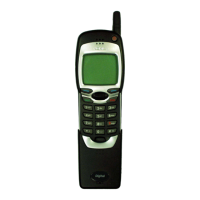NSW-5
Disassembly and Troubleshooting Instructions
PAMS Technical Documentation
Page 30
Issue 1 10/00
Nokia Mobile Phones Ltd.
Receiver
General Instructions for RX Troubleshooting
Start the Wintesla–software and use it to start the desired RX–mode of
the mobile phone. The troubleshooting flowchart is divided into three
steps, general checking, local cheking and RX–chain checking. Please
notice that before changing ASICs or filters, all solderings and missing
components are checked.
IF any RX–filters and/or ASICs are changed, AGC– and RSSI–tun-
ings have to be made!
Connect the desired channel frequency and level to the external antenna
(RF) connector (notice different input levels of signal with AMPS,
TDMA800 and TDMA1900).
It’s recommended to use ”
0 dB attenuation
”–setting in spectrum analyzer
(better to measure weak signals). When measuring TDMA800 and
TDMA1900 signal levels it’s recommended to use ”
MAX HOLD
”–option of
spectrum analyzer (better to measure pulsed signals).
Note! Measurement results of RF–signal level (dBm) in fault finding
charts are measured with active RF–probe (low input capacitance and
high input impedance).
Also note that the measurement results in RX Troubleshooting charts are
typical (approximate) values.
Path of the received signal
Block level description of the receiver:
Antenna –
Diplexer –
Duplexer –
Low Noise Amplifier (LNA) –
RX filter –
First mixer –
116.19 MHz filter –
IF–amplifier –
AGC/buffer –
second mixer –
450 kHz filters –
buffer/limiter –
Baseband( FM–detector).

